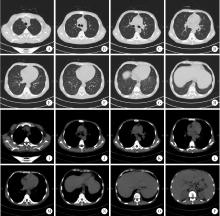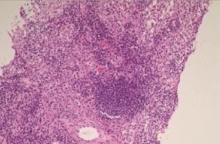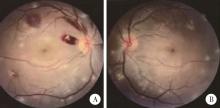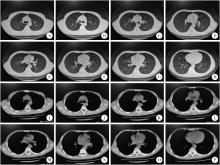Journal of Peking University (Health Sciences) ›› 2022, Vol. 54 ›› Issue (6): 1219-1223. doi: 10.19723/j.issn.1671-167X.2022.06.027
Previous Articles Next Articles
Hemophagocytic lymphohistiocytosis caused by hematogenous disseminated pulmonary tuberculosis: A case report
Qiu-yu LI1,Ying LIANG1,Ni-ni DAI1,Yu-xiang WANG2,Bo-tao ZHU1,Rui WU1,Hong ZHU1,*( ),Yong-chang SUN1
),Yong-chang SUN1
- 1. Department of Respiratory and Critical Care Medicine, Peking University Third Hospital, Beijing 100191, China
2. Department of Pathology, Peking University Third Hospital, Beijing 100191, China
CLC Number:
- R521.1
| 1 |
中华医学会放射学分会传染病放射学专业委员会. 肺结核影像学及分级诊断专家共识[J]. 新发传染病电子杂志, 2018, 3 (2): 118- 127.
doi: 10.3877/j.issn.2096-2738.2018.02.017 |
| 2 |
Schram AM , Berliner N . How I treat hemophagocytic lymphohis-tiocytosis in the adult patient[J]. Blood, 2015, 125 (19): 2908- 2914.
doi: 10.1182/blood-2015-01-551622 |
| 3 |
Henter JI , Home A , Arico M , et al. HLH-2004: diagnostic and therapeutic guidelines for hemophagocytic lymphohistiocytosis[J]. Pediatr Blood Cancer, 2007, 48 (2): 124- 131.
doi: 10.1002/pbc.21039 |
| 4 |
Darmawan G , Salido EO , Concepcion ML , et al. Hemophagocytic lymphohistiocytosis: "A dreadful mimic"[J]. Int J Rheum Dis, 2015, 18 (7): 810- 812.
doi: 10.1111/1756-185X.12506 |
| 5 |
Zhang Y , Liang G , Qin H , et al. Tuberculosis-associated hemophagocytic lymphohistiocytosis with initial presentation of fever of unknown origin in a general hospital: An analysis of 8 clinical cases[J]. Medicine, 2017, 96 (16): e6575.
doi: 10.1097/MD.0000000000006575 |
| 6 |
Asaji M , Tobino K , Murakami K , et al. Miliary tuberculosis in a young woman with hemophagocytic syndrome: A case report and literature review[J]. Intern Med, 2017, 56 (12): 1591- 1596.
doi: 10.2169/internalmedicine.56.8025 |
| 7 | Shea YF , Chan JF , Kwok WC , et al. Haemophagocytic lymphohistiocytosis: an uncommon clinical presentation of tuberculosis[J]. Hong Kong Med J, 2012, 18 (6): 517- 525. |
| [1] | Hai-hong YAO,Fan YANG,Su-mei TANG,Xia ZHANG,Jing HE,Yuan JIA. Clinical characteristics and diagnostic indicators of macrophage activation syndrome in patients with systemic lupus erythematosus and adult-onset Still's disease [J]. Journal of Peking University (Health Sciences), 2023, 55(6): 966-974. |
| [2] | Wei-bo GAO,Mao-jing SHI,Hai-yan ZHANG,Chun-bo WU,Ji-hong ZHU. Relationship between marked hyperferritinemia and hemophagocytic lymphohistiocytosis [J]. Journal of Peking University (Health Sciences), 2021, 53(5): 921-927. |
| [3] | ZHANG Jia-wei, HAN Pei-en, YANG Li. Spatial accessibility of fever clinics for multi-tiered prevention and control on COVID-19 in Beijing [J]. Journal of Peking University (Health Sciences), 2021, 53(3): 543-548. |
| [4] | Yu-qing OUYANG,Lian-fang NI,Xin-min LIU. Prognosis factors analysis of patients with malignant solitary pulmonary nodules [J]. Journal of Peking University(Health Sciences), 2020, 52(1): 158-162. |
| [5] | WANG He, HU Zhao-heng, CHEN Ling2, PAN Yu3. Influence of history of oral bisphosphonates on the incidence rate of fever after intravenous injection of zoledronic acid in patients with osteoporosis [J]. Journal of Peking University(Health Sciences), 2016, 48(4): 680-682. |
| [6] | KANG Lei, XU Xiao-Jie, FAN Yan, WANG Rong-Fu, MA Chao, FU Zhan-Li, ZHANG Jian-Hua, ZHANG Xu-Chu. Diagnostic value of fluorine-18 fluorodeoxyglucose positron emission tomography/computed tomography in fever of unknown origin [J]. Journal of Peking University(Health Sciences), 2015, 47(1): 175-180. |
| [7] | NI Lian-Fang, LIU Xin-Min. Diagnostic value of serum tumor markers in differentiating malignant from benign solitary pulmonary nodules [J]. Journal of Peking University(Health Sciences), 2014, 46(5): 707-710. |
|
||









